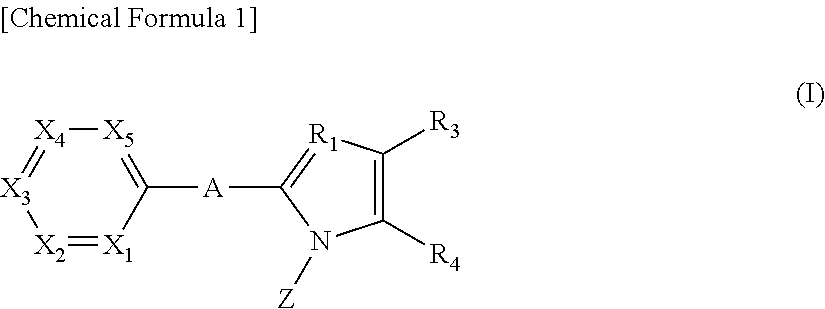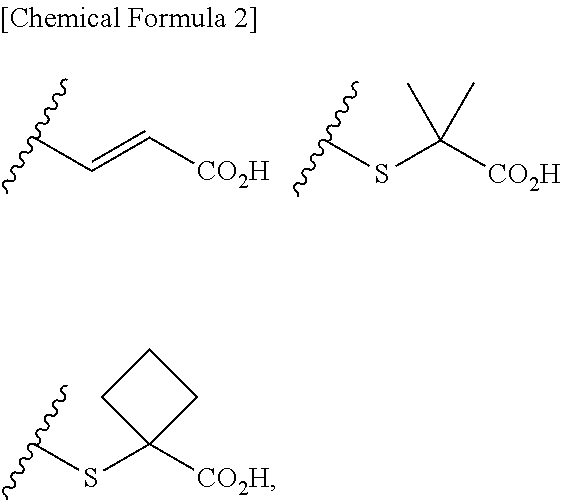Pyridine derivative
a technology of pyridine and derivatives, applied in the field of pyridine derivatives, can solve problems such as hyperuricemia induced
- Summary
- Abstract
- Description
- Claims
- Application Information
AI Technical Summary
Benefits of technology
Problems solved by technology
Method used
Image
Examples
example 1
Production of 4-methyl-1-(naphthalen-1-ylmethyl)-2-(pyridin-3-yl)-1H-imidazole-5-carboxylic acid (Compound A2) (Scheme A)
[0126]
(1) Ethyl 4-methyl-1H-imidazole-5-carboxylate (7.5 g, 48.7 mmol) was dissolved in acetonitrile (120 mL), N-bromosuccinimide (10.4 g, 58.4 mmol) was added thereto, and then the mixture was stirred at room temperature for 3 hours. After the reaction, saturated aqueous sodium hydrogen carbonate was added and the mixture was extracted twice with ethyl acetate. After washing with saturated aqueous sodium chloride, the organic layer was dried over anhydrous sodium sulfate. After concentrating the organic layer, the residue was purified by column chromatography to obtain ethyl 2-bromo-4-methyl-1H-imidazole-5-carboxylate (3.6 g):
[0127]1H-NMR (CDCl3) δ: 4.35 (2H, q, J=7.1 Hz), 2.51 (3H, s), 1.37 (3H, t, J=7.1 Hz);
[0128]ESI-MS m / z=233 (M++H).
(2) Ethyl 2-bromo-4-methyl-1H-imidazole-5-carboxylate (5 g, 21.45 mmol) was dissolved in DMF (40 mL), potassium carbonate (5.93 ...
example 2
Production of 1-((4-chlorobenzo[b]thiophen-3-yl)methyl)-4-methyl-2-(pyridin-3-yl)-1H-imidazole-5-carboxylic acid (Compound A7) (Scheme A)
[0137]
(1) Ethyl 2-bromo-4-methyl-1H-imidazole-5-carboxylate (1.52 g, 6.0 mmol), (4-chlorobenzo[b]thiophen-3-yl)methanol (1.79 g, 9.0 mmol) obtained according to a method described in a literature (for example, WO 2002 / 066457), and triphenylphosphine (2.36 g, 9.0 mmol) were dissolved in THF (15 mL), a 1.9 M solution of DIAD in toluene (4.73 mL, 9.0 mmol) was added dropwise thereto under cooling at 0° C., and the mixture was stirred at 30° C. for 10 hours. The solvent was distilled away and the residue was purified by column chromatography to obtain ethyl 2-bromo-1((4-chlorobenzo[b]thiophen-3-yl)methyl)-4-methyl-1H-imidazole-5-carboxylate (1.73 g):
[0138]1H-NMR (CDCl3) δ: 7.72 (1H, d, J=8.3 Hz), 7.41-7.24 (3H, m), 6.15 (2H, s), 4.21 (2H, q, J=7.1 Hz), 2.57 (3H, s), 1.20 (3H, t, J=7.1 Hz);
[0139]ESI-MS m / z=413 (M++H).
(2) Ethyl 2-bromo-1-((4-chlorobenzo[...
example 3
Production of 4-chloro-1-(napthalen-1-ylmethyl)-2-(pyridin-3-yl)-1H-imidazole-5-carboxylic acid (Compound A9) (Scheme D)
[0145]
(1) 3-Amidinopyridine hydrochloride (10 g, 63.5 mmol), dihydroxyacetone dimer (11.43 g, 63.6 mmol) and ammonium chloride (17 g, 317 mmol) were dissolved in 28% aqueous ammonia (100 mL), and the solution was stirred at 80° C. for 2 hours. After the reaction, saturated aqueous sodium chloride (50 mL) was added and the aqueous layer was extracted three times with a mixed solvent of ethyl acetate and THF. The organic layer was dried over anhydrous sodium sulfate and concentrated to obtain a crude product, which was subsequently washed with acetonitrile and hexane to obtain (2-(pyridin-3-yl)-1H-imidazol-5-yl)methanol (3 g):
[0146]ESI-MS m / z=176 (M++H).
(2) In a mixed solvent of ethanol (30 mL) and 1,4-dioxane (30 mL) was dissolved (2-(pyridin-3-yl)-1H-imidazol-5-yl)methanol (2.1 g, 12 mmol), N-chlorosuccinimide (1.6 g, 12 mmol) was added thereto, and the mixture was...
PUM
| Property | Measurement | Unit |
|---|---|---|
| temperature | aaaaa | aaaaa |
| temperature | aaaaa | aaaaa |
| temperature | aaaaa | aaaaa |
Abstract
Description
Claims
Application Information
 Login to View More
Login to View More - R&D
- Intellectual Property
- Life Sciences
- Materials
- Tech Scout
- Unparalleled Data Quality
- Higher Quality Content
- 60% Fewer Hallucinations
Browse by: Latest US Patents, China's latest patents, Technical Efficacy Thesaurus, Application Domain, Technology Topic, Popular Technical Reports.
© 2025 PatSnap. All rights reserved.Legal|Privacy policy|Modern Slavery Act Transparency Statement|Sitemap|About US| Contact US: help@patsnap.com



